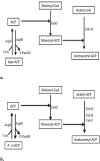A comprehensive review on oleaginous bacteria: an alternative source for biodiesel production
- PMID: 38647556
- PMCID: PMC10992283
- DOI: 10.1186/s40643-022-00527-1
A comprehensive review on oleaginous bacteria: an alternative source for biodiesel production
Abstract
Due to continuously increasing population, industrialization, and environmental pollution, lead to generating high energy demand which suitable for our environment. Biodiesel is an alternative renewable fuel source. According to the feedstock of production, biodiesel has been categorized into four generations. The main disadvantage of the first and second generation is the raw material processing cost that the challenge for its industrial-level production. Oleaginous bacteria that contain more than 20% lipid of their cellular biomass can be a good alternative and sustainable feedstock. Oleaginous bacteria used as feedstock have numerous advantages, such as their high growth rate, being easy to cultivate, utilizing various substrates for growth, genetic or metabolic modifications possible. In addition, some species of bacteria are capable of carbon dioxide sequestration. Therefore, oleaginous bacteria can be a significant resource for the upcoming generation's biodiesel production. This review discusses the biochemistry of lipid accumulation, screening techniques, and lipid accumulation factors of oleaginous bacteria, in addition to the overall general biodiesel production process. This review also highlights the biotechnological approach for oleaginous bacteria strain improvement that can be future used for biodiesel production and the advantages of using general biodiesel in place of conventional fuel, along with the discussion about global policies and the prospect that promotes biodiesel production from oleaginous bacteria.
Keywords: Bio-harvesting; Biodiesel; Feedstock; Oleaginous microbes; Transesterification.
© 2022. The Author(s).
Conflict of interest statement
The authors declare that they have no competing interests.
Figures





Similar articles
-
Potential of oleaginous microbes for lipid accumulation and renewable energy generation.World J Microbiol Biotechnol. 2024 Oct 3;40(11):337. doi: 10.1007/s11274-024-04145-1. World J Microbiol Biotechnol. 2024. PMID: 39358563 Review.
-
Liquid wastes as a renewable feedstock for yeast biodiesel production: Opportunities and challenges.Environ Res. 2022 May 1;207:112100. doi: 10.1016/j.envres.2021.112100. Epub 2021 Oct 4. Environ Res. 2022. PMID: 34619127 Review.
-
Evaluating the Potential of Oleaginous Yeasts as Feedstock for Biodiesel Production.Protein Pept Lett. 2018;25(2):195-201. doi: 10.2174/0929866525666180122112805. Protein Pept Lett. 2018. PMID: 29359654
-
Isolation, characterization and optimization of oleaginous Providencia vermicola as a feedstock for biodiesel production using Response Surface Methodology.Prep Biochem Biotechnol. 2024 Nov;54(10):1226-1242. doi: 10.1080/10826068.2024.2344516. Epub 2024 May 10. Prep Biochem Biotechnol. 2024. PMID: 38727011
-
Simultaneous lipid production for biodiesel feedstock and decontamination of sago processing wastewater using Candida tropicalis ASY2.Biotechnol Biofuels. 2020 Mar 5;13:35. doi: 10.1186/s13068-020-01676-1. eCollection 2020. Biotechnol Biofuels. 2020. PMID: 32158499 Free PMC article.
Cited by
-
Oleaginous fungi: a promising source of biofuels and nutraceuticals with enhanced lipid production strategies.Arch Microbiol. 2024 Jul 2;206(7):338. doi: 10.1007/s00203-024-04054-9. Arch Microbiol. 2024. PMID: 38955856 Review.
-
Two protocols for the detection of oleaginous bacteria using Oil Red O.Appl Microbiol Biotechnol. 2024 Jun 15;108(1):375. doi: 10.1007/s00253-024-13177-4. Appl Microbiol Biotechnol. 2024. PMID: 38878165 Free PMC article.
-
Exploring the landscape of Lipid Nanoparticles (LNPs): A comprehensive review of LNPs types and biological sources of lipids.Int J Pharm X. 2024 Nov 18;8:100305. doi: 10.1016/j.ijpx.2024.100305. eCollection 2024 Dec. Int J Pharm X. 2024. PMID: 39669003 Free PMC article. Review.
-
Potential of oleaginous microbes for lipid accumulation and renewable energy generation.World J Microbiol Biotechnol. 2024 Oct 3;40(11):337. doi: 10.1007/s11274-024-04145-1. World J Microbiol Biotechnol. 2024. PMID: 39358563 Review.
-
Sustainable biodiesel production: importance of feedstock resources and production methods.RSC Adv. 2025 Jul 28;15(33):26739-26754. doi: 10.1039/d5ra03084f. eCollection 2025 Jul 25. RSC Adv. 2025. PMID: 40727288 Free PMC article. Review.
References
-
- Abdullah MA, Nazir MS, Raza MR, et al. Autoclave and ultra-sonication treatments of oil palm empty fruit bunch fibers for cellulose extraction and its polypropylene composite properties. J Clean Prod. 2016;126:686–697. doi: 10.1016/j.jclepro.2016.03.107. - DOI
-
- Acharya RN, Perez-Pena R. Role of comparative advantage in biofuel policy adoption in Latin America. Sustainability. 2020;12:1411. doi: 10.3390/su12041411. - DOI
-
- Adhikaria S, Illukpitiya P. Small-scale biodiesel production for on-farm energy security: a sustainable income diversification opportunity for oilseed producers. Biofuels. 2021 doi: 10.1080/17597269.2021.1872290. - DOI
-
- Alalwana HA, Alminshidb AH, Aljaafari HAS. Promising evolution of biofuel generations. Renew Energy Focus. 2019;8:127–139. doi: 10.1016/j.ref.2018.12.006. - DOI
Publication types
Grants and funding
LinkOut - more resources
Full Text Sources

